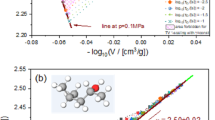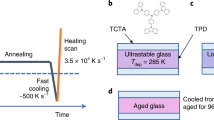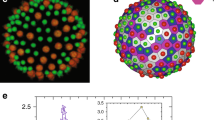Abstract
The increasingly sluggish response of a supercooled liquid as it nears its glass transition1 (for example, refrigerated honey) is prototypical of glassy dynamics found in proteins, neural networks and superconductors. The notion that molecules rearrange cooperatively has long been postulated2 to explain diverging relaxation times and broadened (non-exponential) response functions near the glass transition. Recently, cooperativity was observed and analysed in colloid glasses3 and in simulations of binary liquids well above the glass transition4. But nanometre-scale studies of cooperativity at the molecular glass transition are lacking5. Important issues to be resolved include the precise form of the cooperativity and its length scale6, and whether the broadened response is intrinsic to individual cooperative regions, or arises only from heterogeneity7,8,9 in an ensemble of such regions. Here we describe direct observations of molecular cooperativity near the glass transition in polyvinylacetate (PVAc), using nanometre-scale probing of dielectric fluctuations. Molecular clusters switched spontaneously among two to four distinct configurations, producing random telegraph noise. Our analysis of these noise signals and their power spectra reveals that individual clusters exhibit transient dynamical heterogeneity and non-exponential kinetics.
This is a preview of subscription content, access via your institution
Access options
Subscribe to this journal
Receive 51 print issues and online access
$199.00 per year
only $3.90 per issue
Buy this article
- Purchase on Springer Link
- Instant access to full article PDF
Prices may be subject to local taxes which are calculated during checkout





Similar content being viewed by others
References
Angell, C. A. Formation of glasses from liquids and biopolymers. Science 267, 1924–1939 (1995).
Adam, G. & Gibbs, J. H. On the temperature dependence of cooperative relaxation properties in glass forming liquids. J. Chem. Phys. 43, 139–146 (1965).
Weeks, E. R., Crocker, J. L., Levitt, A. C., Schofield, A. & Weitz, D. A. Three-dimensional direct imaging of structural relaxation near the colloidal glass transition. Science 287, 627–629 (2000).
Bennemann, C., Donati, C., Baschnagel, J. & Glotzer, S. C. Growing range of correlated motion in a polymer melt on cooling towards the glass transition. Nature 399, 246–249 (1999).
Binder, K., Baschnagel, J., Kob, W. & Paul, W. Glass physics: still not transparent. Phys. World 12, 54 (1999).
Tracht, U. et al. Length scale of dynamic heterogeneities at the glass transition determined by multidimensional nuclear magnetic resonance. Phys. Rev. Lett. 81, 2728–2731 (1998).
Schiener, B., Bohmer, R., Loidl, A. & Chamberlin, R. V. Nonresonant spectral hole burning in the slow dielectric response of supercooled liquids. Science 274, 752–754 (1996).
Bohmer, R. et al. Nature of the nonexponential primary relaxation in structural glasses probed by dynamically selective experiments. J. Non-Cryst. Solids 235, 1–8 (1998).
Ediger, M. D. Spatially heterogeneous dynamics in supercooled liquids. Annu. Rev. Phys. Chem. 51, (in the press).
Dixon, P. K., Wu, L., Nagel, S. R., Williams, B. D. & Carini, J. P. Scaling in the relaxation of a supercooled liquid. Phys. Rev. Lett. 65, 1108–1111 (1990).
Arbe, A., Colmenero, J., Monkenbusch, M. & Richter, D. Dynamics of glass forming polymers: “homogeneous” vs. “heterogeneous” scenario. Phys. Rev. Lett. 81, 590–593 (1998).
Grigera, T. S. & Israeloff, N. E. Observation of fluctuation-dissipation-theorem violations in a structural glass. Phys. Rev. Lett. 83, 5038–5041 (1999).
Martin, Y., Abraham, D. W. & Wickramasinghe, H. K. High-resolution capacitance measurement and potentiometry by force microscopy. Appl. Phys. Lett. 52, 1103–1105 (1988).
Walther, L. E., Israeloff, N. E., Vidal Russell, E. & Alvarez Gomariz, H. Mesoscopic scale dielectric relaxation at the glass transition. Phys. Rev. B 57, R15112–R15115 (1998).
Vidal Russell, E., Walther, L. E., Israeloff, N. E. & Alvarez Gomariz, H. Nanometer scale dielectric fluctuations at the glass transition. Phys. Rev. Lett. 81, 1461–1464 (1998).
Walther, L. E., Vidal Russell, E., Israeloff, N. E. & Alvarez Gomariz, H. Atomic force measurement of low frequency dielectric noise. Appl. Phys. Lett. 72, 3223–3226 (1998).
Albrecht, T. R., Grütter, P., Horne, D. & Rugar, D. Frequency modulation detection using high-Q cantilevers for enhanced force microscope sensitivity. J. Appl. Phys. 69, 668–673 (1991).
Forrest, J. A., Dalnoki-Veress, K., Stevens, J. R. & Dutcher, J. R. Effect of free surfaces on the glass transition temperature of thin polymer films. Phys. Rev. Lett. 77, 2002–2005 (1996).
McCrum, N. G., Read, B. E. & Williams, G. Anelastic And Dielectric Effects In Polymeric Solids 302–305 (Dover, New York, 1991).
Tracht, U., Heuer, A., Spiess, H. W. Geometry of reorientational dynamics in supercooled poly(vinyl acetate) studied by 2D NMR echo experiments. J. Phys. Chem. 111, 3720–3727 (1999).
Xia, X. & Wolynes, P. G. Fragilities of liquids predicted from the random first order transition theory of glasses. Proc. Natl Acad. Sci. USA 97, 2990–2994 (2000).
Wang, J. & Wolynes, P. Intermittency of single molecule reaction dynamics in fluctuating environments. Phys. Rev. Lett. 74, 4317–4320 (1995).
Acknowledgements
This research was supported by the NSF Division of Materials Research, and the Petroleum Research Fund administered by the American Chemical Society. We thank M. D. Ediger for helpful discussions and K. Sinnathamby for assistance.
Author information
Authors and Affiliations
Rights and permissions
About this article
Cite this article
Vidal Russell, E., Israeloff, N. Direct observation of molecular cooperativity near the glass transition. Nature 408, 695–698 (2000). https://doi.org/10.1038/35047037
Received:
Accepted:
Issue Date:
DOI: https://doi.org/10.1038/35047037
This article is cited by
-
Real-time microscopy of the relaxation of a glass
Nature Physics (2023)
-
DSC investigation of chain cooperativity rearrangements and critical length scale of polybutadiene networks in glass transition range
Journal of Thermal Analysis and Calorimetry (2022)
-
Glass transition analysis of model metallosupramolecular polyesters bearing pendant pyridine ligands with a controlled ligand–ligand distance
Polymer Journal (2020)
-
Direct imaging of structural disordering and heterogeneous dynamics of fullerene molecular liquid
Nature Communications (2019)
-
The Magic of Disaccharide Glass Matrices for Protein Function as Decoded by High-Field EPR and FTIR Spectroscopy
Applied Magnetic Resonance (2015)
Comments
By submitting a comment you agree to abide by our Terms and Community Guidelines. If you find something abusive or that does not comply with our terms or guidelines please flag it as inappropriate.



